2019 年浙江宁波大学二外英语考研真题
Part I Cloze Test (20 points, 1 point each)
Directions: In this part you are required to read the given passages carefully, and
then fill in each blank with an appropriate word given in the boxes. Each word is
allowed to be used only once. You should not change the form of the word but you
can capitalize the initial letter if the word is used at the beginning of the sentence.
Write your choices in the Answer Sheet.
that
why
because
whose
so
or
if
but
while
what
1
2
you’re doing and focus on that?
3
4
Do you find it difficult to sit in a desk chair and work for 15 minutes, yet easy
and natural to sit at a piano bench for two hours playing tunes?
, in school,
was it impossible to remember geometrical equations, while you can rattle off all
the music notes? Or, do you sometimes get great ideas for songs, and immediately
stop
a few of these are true, you might
have ADD tendencies.
Attention deficit disorder, or ADD, is a group of disorders
affects
approximately 5 to 1l percent of the population, more common in boys than girls,
and in children than adults. A person with ADD could have difficulty concentrating,
be constantly in motion, may come across as uncontrollable, may have abnormal
tendencies to overly focus on something. In many cases, an ADD individual will
compensate by seeking to intensify the amount of stimulation in their brain through
seeking conflict, self-medicating with coffee / tobacco / alcohol / drugs, and a
host of other behaviors of varying degrees healthiness or self-destructiveness.
Music is stimulating, and focusing on practice or listening can lead to increased
proficiency,
music is a natural fit for many with ADD. That’s a potential
reason
able to focus on music
theory:
music can stimulate an underactive brain. Typically, ADD is
associated with low activity in the brain, and music helps to raise blood flow and
overall activities. It can enhance neuronal connection.
9
ADD is considered a disorder, in fact, many people with ADD are high achievers
and may even consider it a benefit, and part of what makes them unusually effective.
The internet is abundant with lists of famous musicians who reportedly have
ADD---some by their own admission and others
diagnosis is widely
speculative.
Passage Two
some feel unable to focus on geometry,
10
7
5
6
8
recover
approach
approved
manage
aimed
unfortunate
ly
original
controversy
positive
permanent
�
11
12
15
13
14
Anyone who has ever seen the reality show, The Biggest Loser, knows that it offers
a cash prize to the contestant who manages to lose the highest percentage of weight
over the course of a season. Along with
over the various weight loss methods
used on the show, including diet pills, unhealthy diets, and aggressive exercise
regimens, there was also the simple fact that this
doesn’t seem to work
very well. Not only have studies shown that contestants often gain back the weight
they lost but some even gained even more weight afterward.
to lose weight, their metabolisms rarely
Even for contestant who did
followed suit. As a result,
weight loss becomes virtually impossible.
According to one New York Times report describing one of these studies, “What
shocked the researchers was what happened next: As the years went by and the numbers
on the scale climbed, the contestants’ metabolisms did not
. It was as if
their bodies were intensifying their effort to pull the contestants back to their
16
diets and exercise programs,
Even for people losing weight using medically
. For
research into their long-term success has rarely found they have been
that matter, schools and workplace settings, often alarmed by reports of an “obesity
epidemic”, frequently implement programs
at getting children and workers
to lose weight, usually through such strategies as encouraging better nutrition and
more exercise.
, they have not lived up to people’s expectation.
weight.”
18
20
17
19
Part II Reading Comprehension (40 points)
Section A (10 points, 1 point each)
Directions: In this section, there is a passage with ten blanks. You are required
to select one word for each blank from a list of choices given in a word bank following
the passage. Write your choices in the Answer Sheet.
2
a family member’s extremely horrible health emergency.
I haven’t slept very well this week, and perhaps as a result, have had some
nightmares. My dream last night was so upsetting that I actually don’t want to
describe it, for fear that somehow it might come true, but I’ll just say that it
1
Thankfully this sort of thing doesn’t happen to me too often, but when it does,
it leaves me emotionally drained and
all day — even though I know what I
dreamt isn’t “real.” I tend to feel guilty about dwelling on something I only
3
, but according to Alice Robb, author of Why We Dream: The Transformative Power
of Our Nightly Journey, out later this month, it’s
to experience real,
bodily effects after traumatic dreams. “Emotions and stress experienced in dreams
can have very real emotional and physiological
,” she says. “There are even
a few reported cases in which nightmares seem to have contributed to heart attacks.”
6
, there are some strategies people can employ to reduce their nightmares’
frequency and harm. In the long-term, Robb suggests practicing some dream techniques
during the day. In her book, she writes: “If people can learn to become
in
their dreams, they can wake themselves up or even drive away their dream-foes.”
4
5
7
�
She describes a 2006 experiment done by psychologists at Utrecht University in the
Netherlands, in which the researchers asked some
to practice clear dream
induction techniques on their own, gave private clear dreaming lessons to others,
and then left a third group untreated. Both groups that
clear dreaming
techniques saw fewer nightmares as a result: “Patients who learned in private
sessions started out with an average of 3.6 nightmares, and that number went down
to 1.4,” Robb writes. “The
didn’t depend on achieving clarity; several
people who never managed to become clear in their dreams still had a reduction in
nightmares.”
10
8
9
A)
B)
C)
D)
E)
F)
G)
H)
normal
participants
anxious
aroused
involved
practically
imagined
improvement
I)
J)
K)
L)
M)
N)
O)
emotional
fortunately
conscious
comparison
practiced
confirmed
consequences
Section B (30 points, 2 points each)
Directions: There are 3 passages in this section. Each passage is followed by some
questions or unfinished statements. For each of them there are four choices marked
A, B, C and D. You should decide on the best choice and put it in the Answer Sheet.
Passage One
Questions 1 to 5 are based on the following passage.
Women in Australia earn about 82 cents for every man’s dollar. If you look at the
highest paid male and female doctors in the country, the pay gap is even more
pronounced.
However, an interesting new study has found that hospital patients treated by a
female doctor had better health outcomes than those treated by a male doctor. “There
is evidence that men and women may practice medicine differently,” said the paper’s
authors from Harvard Medical School (female physicians in the U.S. earn around 8
per cent less than male counterparts).
Previous studies had found female doctors were more likely to provide preventive
care, communicate well with patients, offering more psychosocial counselling and
perform as well, if not better, on standard examinations.
Researchers had not looked at whether these differences in care extended to patient
outcomes, until now. The researchers evaluated the records of more than 1.5 million
hospitalisations in the United States over a three-year period, looking specifically
at whether patients died within 30 days of the admission date and whether patients
�
were readmitted within 30 days of the discharge date.
They found, with patients treated by a female doctor, a 4 per cent lower mortality
rate and 5 percent reduction in readmission rates “across all medical conditions
we examined”. The papers authors added: “Assuming that the association between
sex and mortality is causal (具有因果关系的), we estimate that approximately 32,000
fewer patients would die if male physicians could achieve the same outcomes as female
physicians every year.”
Despite the findings, the authors do not suggest seeking care only from female
physicians. Apart from the fact that only about 43 per cent of GPs and one-third
(34 per cent) of specialists in Australia are women, they say the study’s purpose
is to begin to understand different patterns of practice that are driving different
health outcomes.
“Understanding exactly why these differences in care quality and practice patterns
exist may provide valuable insights into improving quality of care for all patients,
regardless of who provides their care,” the authors said.
1. What do we learn about doctors in Australia?
A)
B)
C)
D)
Female doctors are more knowledgeable than male ones.
Female doctors earn less than their male counterparts.
They have a close relationship with their patients.
They receiver a higher salary than those in the US.
2. Previous studies found that female doctors ________.
A)
B)
C)
D)
tended to perform higher care quality
paid more attention to patient outcomes
offered more counselling than necessary
performed better in psychological support
3. The researchers from Harvard Medical School found ________.
A) male doctors have ignored the link between sex and mortality
B) patients treated by male doctors have lower readmission rate
C) patients treated by female doctors have a lower death rate
D) female doctors gain a deep insight into the cause of death
4. The word discharge (Last line, Para. 4) most probably means ________.
A) receiving counselling from the doctor
B) being carefully diagnosed by the doctor
C) being examined and hospitalized
D) leaving hospital after being cured
5. The study is intended to _________.
A) bring down the death rate in the hospital
B) help improve the quality of medical care
C) arouse people’s awareness of gender equality
D) suggest the necessity of more female doctors
�
Passage Two
Questions 6 to 10 are based on the following passage.
Plenty of research has shown how negative stereotypes can be harmful to individuals.
For example, telling girls that boys are typically better at maths seems to make
them score worse on maths tests. There is evidence that stereotypes similarly affect
the success of people who identify as ethnic minorities.
Efforts to improve diversity in the workplace have been growing, says Jolien van
Breen at the University of Exeter, UK, but that doesn’t mean harmful stereotypes
have disappeared – expressions of prejudice may have just become more subtle. Van
Breen and her colleagues have investigated how harmful this may be to women.
The team recruited female volunteers, some of whom strongly identified as feminists,
to participate in a number of experiments. The team also asked each participant how
much they identified with traditional concepts of womanhood. Each volunteer then
took a maths test and an anagram test. Both featured increasingly difficult questions,
ending with an unsolvable problem.
Mathematical ability is typically ascribed to men, while women are generally assumed
to be better at language, says van Breen. The volunteers were shown images during
the test to subtly remind them of general gender stereotypes. Some of these depicted
traditional gender roles, with women shopping or cleaning and men fishing or doing
DIY, while others didn’t. The volunteers didn’t know the true purpose of these
images – they thought they were part of a third task, in which they had to say whether
the images depicted hobbies or chores.
The team found that stereotype images prompted the women who didn’t identify with
traditional concepts of being a woman to put more effort into the maths test, spending
longer on the difficult and unsolvable questions. “People try to resist
stereotyping,” says Jenny Veldman at KU Leuven in Belgium. “If confronted with
stereotypes, one way women prove they belong is by distancing themselves from other
women, so that they can be seen as an individual.”
In another test, the volunteers were faced with the philosophical thought experiment
known as the trolley problem (电车难题): should they sacrifice one person to save
the lives of multiple others? The team found that those who identified as feminists
were more likely to sacrifice the person if it was a man – but only if they had
been exposed to gender stereotyped images.
The results suggest that feminists are keenly aware of gender stereotypes, even when
they are presented subliminally (潜意识地), and automatically react to reject them,
says van Breen. “Future research will have to see whether these findings can be
replicated, and whether they hold in other contexts and among other groups,” says
Veldman.
6. We know from the beginning of the passage that ________.
A)girls are making progress in the maths tests
B)more research is needed to help office women
C)negative images exert harmful influence on girls
�
D)females are still faced with expressions of prejudice
7. Jolien van Breen and colleagues probe into the issue of negative stereotypes
because _________.
A) there has been much progress in girls’ ability to calculate
B) subtle prejudice has been disturbing females in the workplace
C) there is still a long way for harmful stereotypes to fade out
D) the society is filled with the gender imbalance in occupations
8. Which of the following best describes the subjects in Jolien van Breen’s
experiment?
A) They are composed of both male and female volunteers.
B) Some volunteers are good at dealing with maths problems.
C) Some participants are strong supporters of womanhood.
D) They choose to sacrifice a man’s life to save their lives.
9. The images prepared by the researchers are intended to ________.
A) lead the participants into the stereotypes
B) prove that women are weak in maths tests
C) distract volunteers from their right judgment
D) arouse volunteers’ interest in the research
10. What can be said of the last two paragraphs?
A) Feminists might sacrifice men’s interest in the face of losses.
B) Feminists are fully conscious of what they are in want of.
C) The research favors the women in pursuit of gender equality.
D) There will be more research with respect to women’s status.
Passage Three
Questions 11 to 15 are based on the following passage.
The comprehension of words is indeed a very complex psycholinguistic process. One
model that psycholinguists have adopted to account for this complexity is Parallel
Distributed Processing (PDP).
A clear example of the usefulness of a PDP approach to the comprehension of words
is an experience many of us encounter on an almost daily basis, what psychologists
term the Tip-Of-the-Tongue (TOT) phenomenon. Because our long-term memory storage
is better for recognition than for recall, we often know that we know a word so that,
even when we can’t recall it from our memory, it is on the tip of our tongue, and
we can instantly recognize the word when it is presented to us. Psycholinguists have
studied this frequent linguistic experience and have discovered several intriguing
aspects of the TOT phenomenon. For one thing, the momentarily lost word isn’t always
completely forgotten; parts of the word are often subject to recall and, most
commonly, these remembered fragments are the first letters or the first syllable.
Another intriguing aspect is that although we cannot reproduce the word, we can
�
instantly recognize any words that are not the one we are trying to recall.
Often we have vague memories of the beginning and the ending of TOT terms but not
the middle, which is, so to speak, submerged. This so-called bathtub effect allows
us to search in a dictionary, since memory of the beginning of the missing word allows
us to access alphabetical files, and conversely, the memory of how the word ends
allows us to use rhyming as one strategy to confirm the word we are searching for.
Often, it is through these search strategies that we suddenly come up with the word,
or recognize it instantly if it is presented to us.
When you first try to recall a TOT word, it seems as if your memory is a complete
blank and you have absolutely no clues about the word in question. Nevertheless,
the more you think about the missing term and the more you contrast it with similar
but not identical words, the more pieces of knowledge you activate so that the network
of associations spreads.
11. What are Tip-Of-the-Tongue terms according to the passage?
A) Words we use in our daily conversation.
B) Words we cannot pronounce correctly.
C) Words we know but cannot write properly.
D) Words we know but cannot recall at the moment.
12. When we recall a TOT word, the long-term memory helps__________.
A) recognize the TOT word
B) reproduce the TOT word
C) bring to mind fragments of the TOT word
D) momentarily remember the TOT word
13. Among the following, what method has been employed in recalling a TOT word?
A) Using the rhyme of the last syllable of the TOT word.
B) Searching information among more pieces of knowledge.
C) Trying to get the missing information about the TOT word.
D) Getting alphabetical information of endings of the TOT word.
14. What does the bathtub effect suggest?
A) People prefer to search words in the dictionary alphabetically.
B) Dictionaries should be compiled on the basis of words’ endings.
C) The middle part of the word are frequently ignored by learners.
D) The initial and ending parts of the words are easy to remember.
15. The author’s purpose in writing the passage is probably to __________.
A) present an explanation of the word formation of TOT words
B) account for active mental processing in recalling TOT terms
C) explain the strategies of retrieving a TOT word from memory
D) encourage learners not to give up when encountering TOT words
Part III Word Formation (10 points, 1 point each)
�
Directions: Fill in each blank with the correct form of the word given at the end
of each sentence and write your answers in the Answer Sheet.
1.__________ to lead is known to damage the brains of young children.(expose)
2.Few guitarists can sing as well as they can play; Eddie, however, is an __________.
(except)
3.He’s a very __________ lad and he wants to play at the highest level. (ambition)
4.I was alarmed by his naivety and __________ of international affairs.(ignore)
5.Ministers have shown extreme __________ to explain their position to the media.
(reluctant)
6.She did not __________ that his interest was just a passing fancy.(suspicion)
7.The average daily __________ of fruit and vegetables is around 200 grams. (consume)
8.The dispute could destroy Australia ’ s hard-won reputation for industrial
__________. (stable)
9.The man wore a bathrobe and had __________ just come from the bathroom.(evidence)
10.They have seen the change as unquestionably __________ to the country.(benefit)
Part IV Translation (15 points, 5 points each)
Directions: In this part you are required to translate the given sentences into
English and you should write your translation in the Answer Sheet.
1.以和为贵是中华民族的传统美德,“和”的思想体现在很多方面。在人与自然的关系上,
人类应当学会认识自然,尊重自然,保护自然。
2.西至嘉峪关,东至山海关的长城是耗时最长、付出生命代价最高的建筑工程。它始建于秦
朝,后续的朝代持续建造。
3.收发红包是中国传统习俗,它寓意祝福和团圆。这一古老习俗再生于网络,其核心体验不
在于红包现金的多寡,而在于每个人参与其中营造的气氛。
Part V Writing (15 points)
Directions: In this part you are required to write a composition of no less than
160 words on the basis of the following information:
Nowadays many people think that new parents should attend parenting courses to learn
how to bring up their children well. To what extent do you agree or disagree?
�
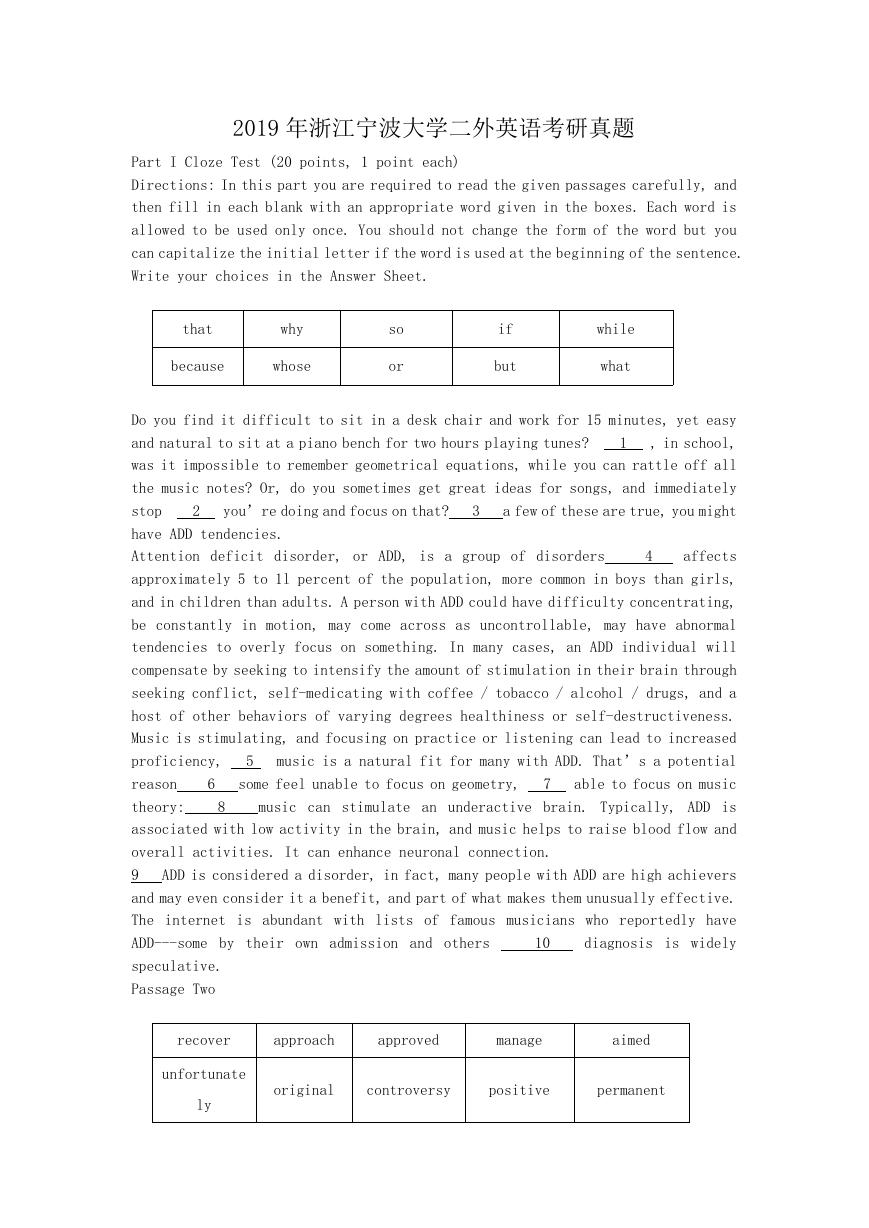
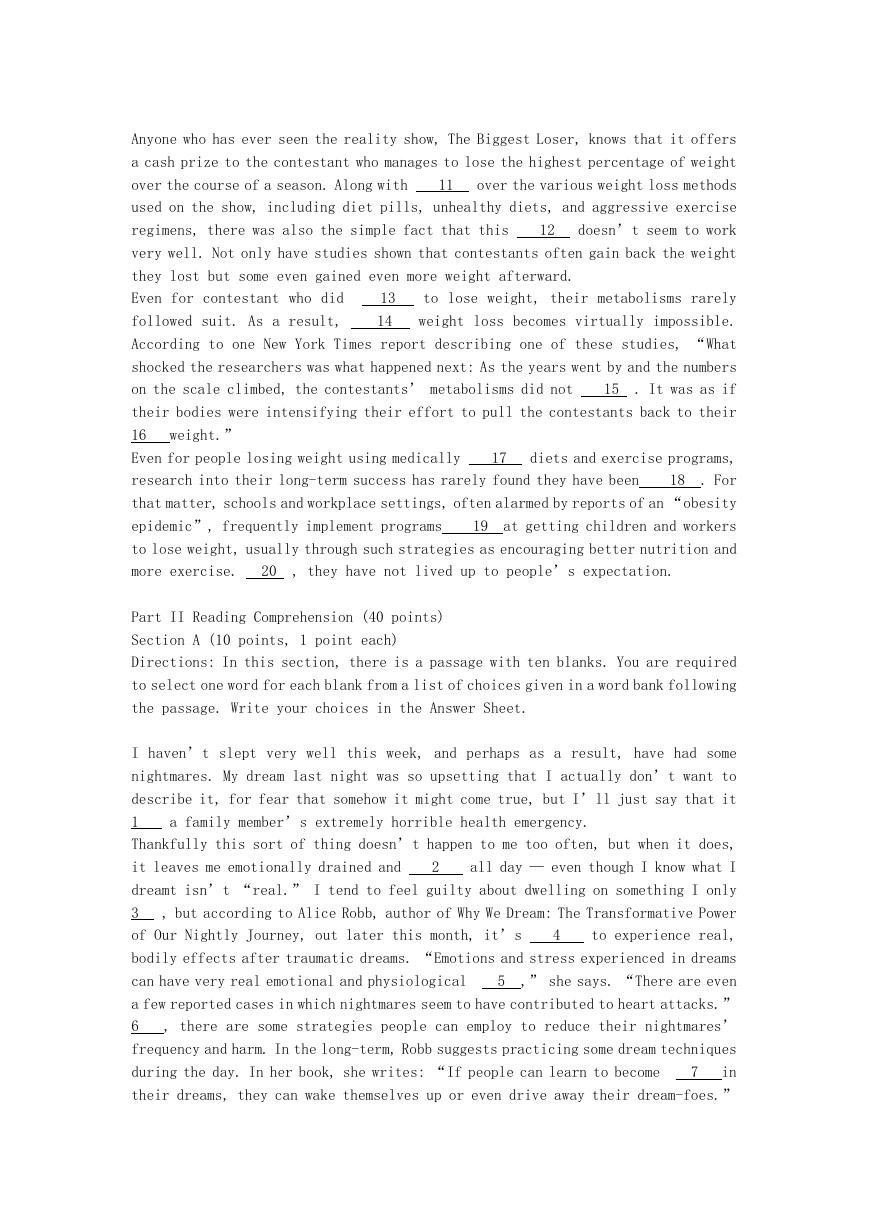
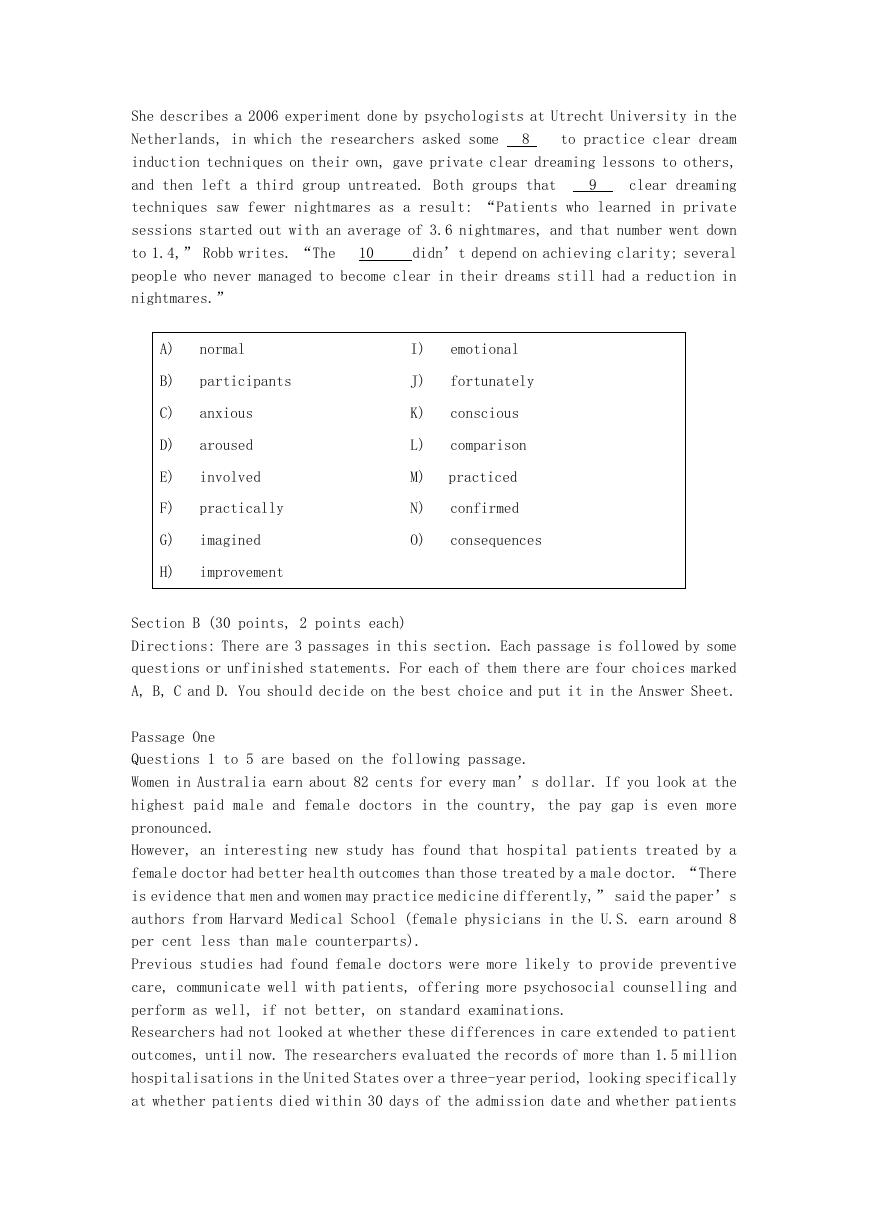
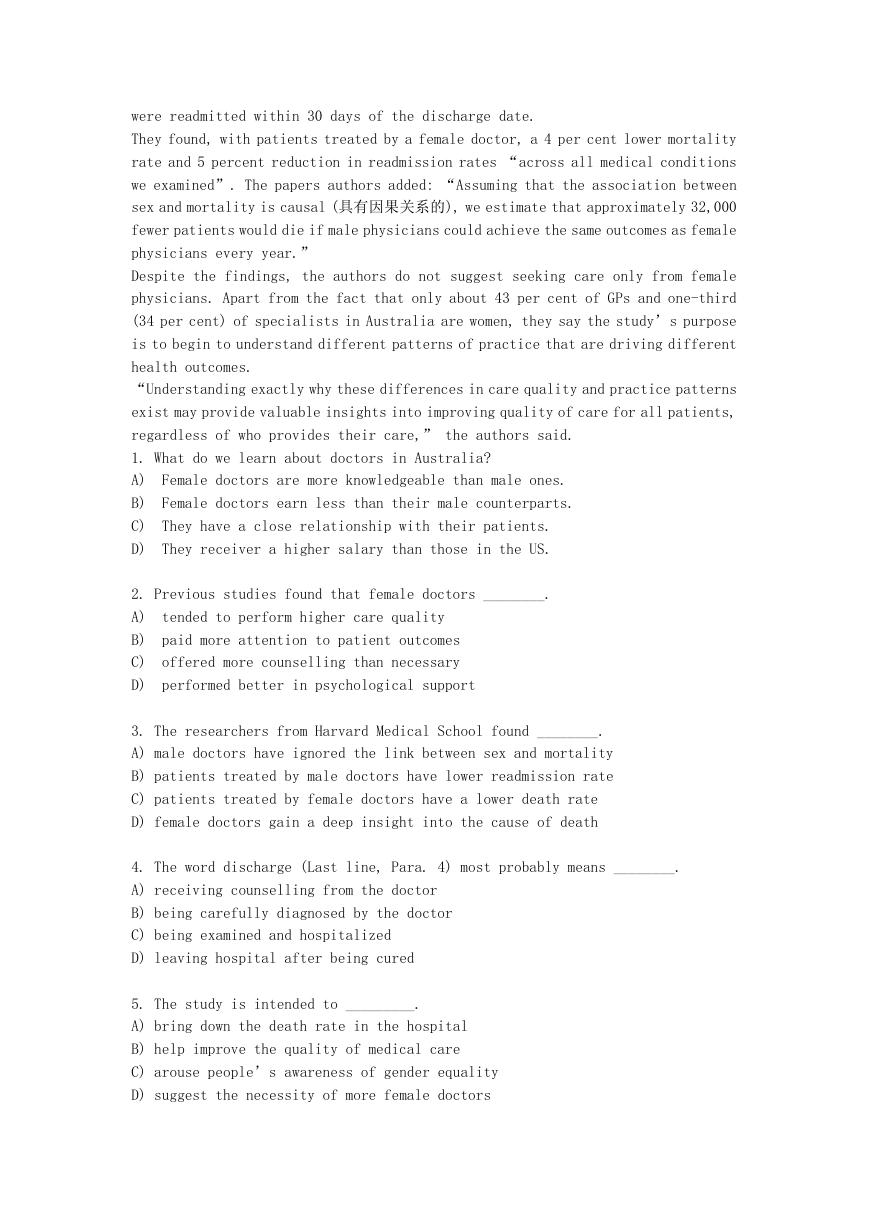
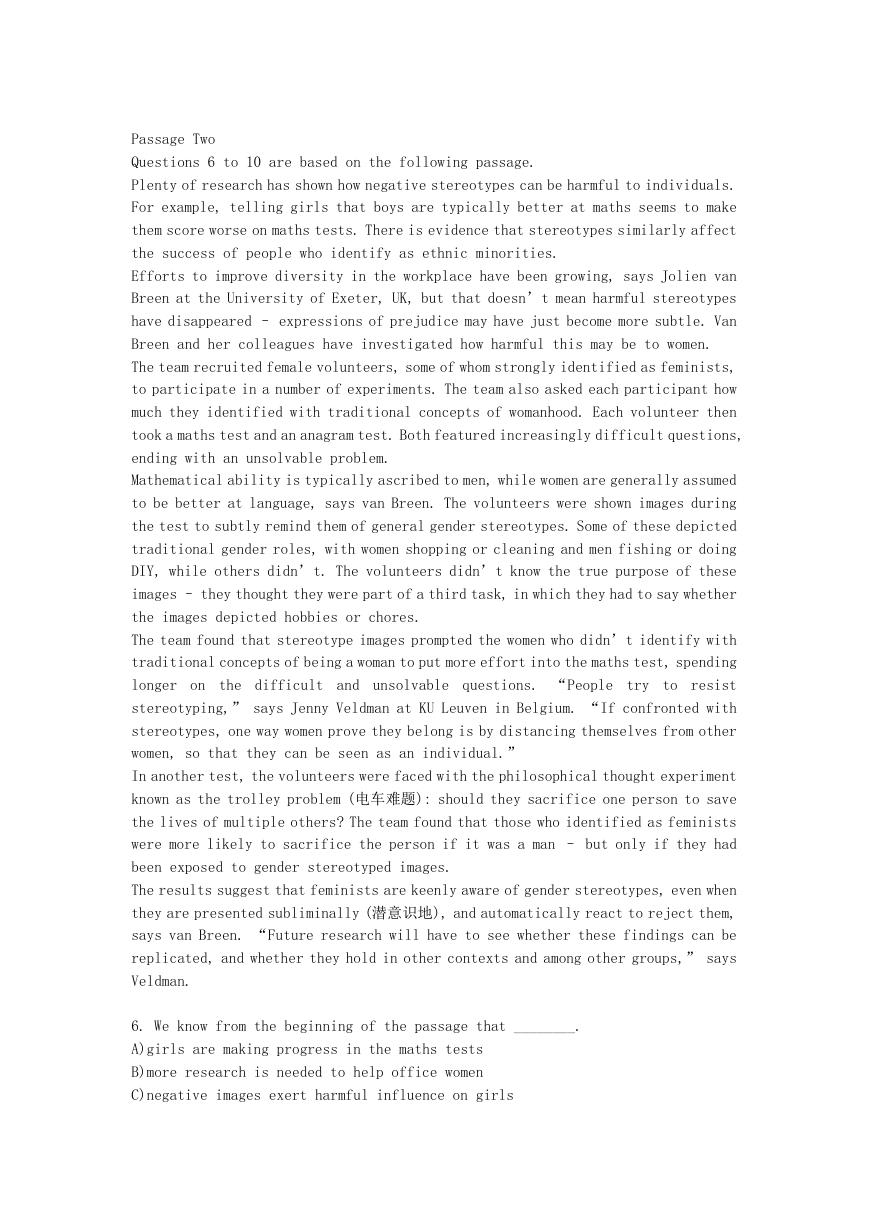
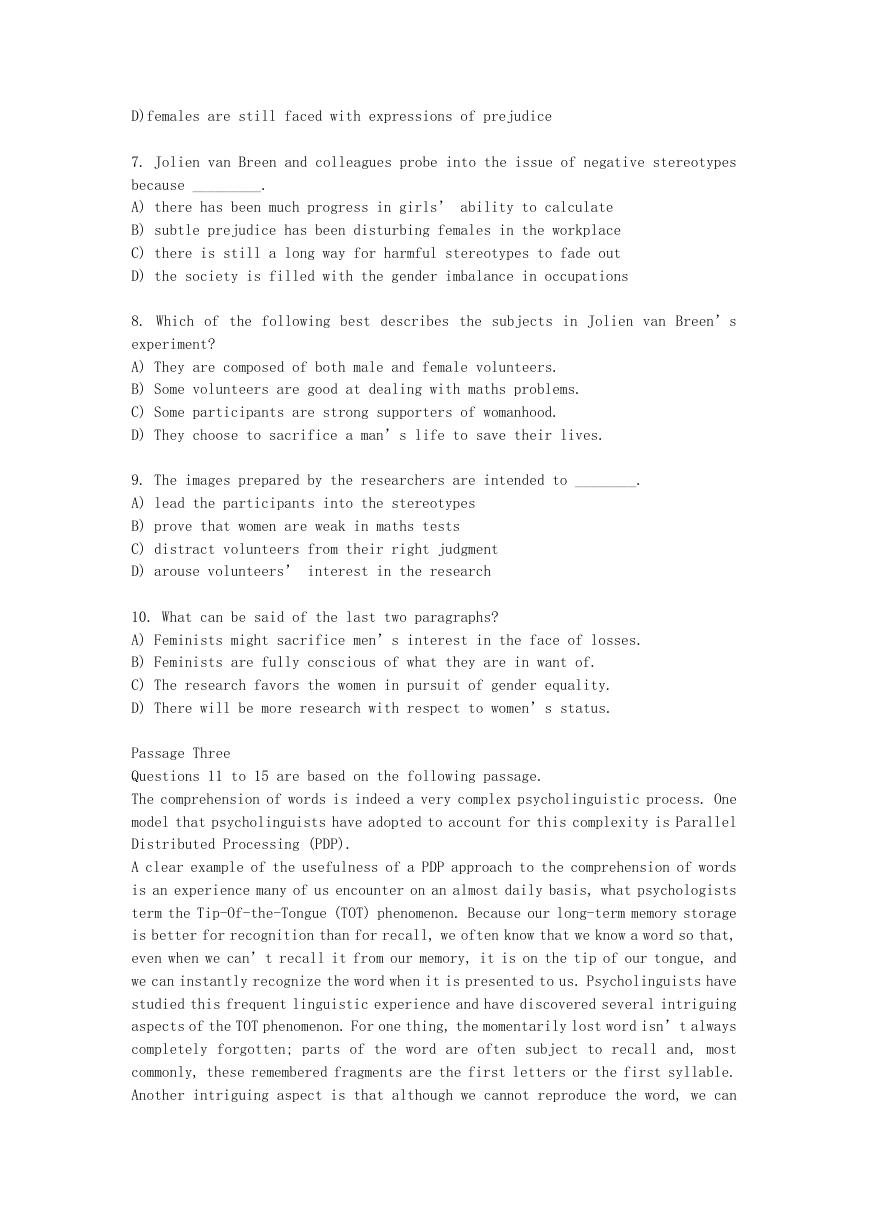
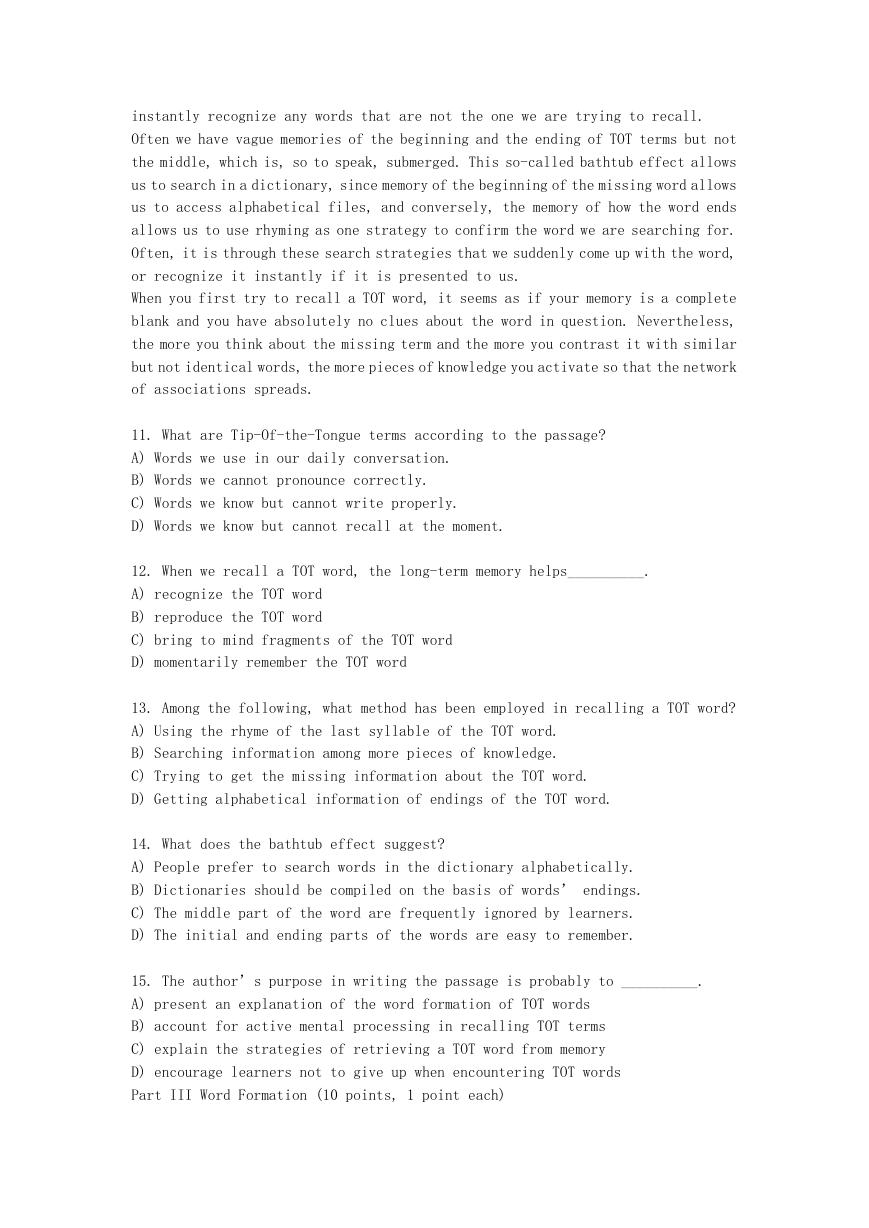
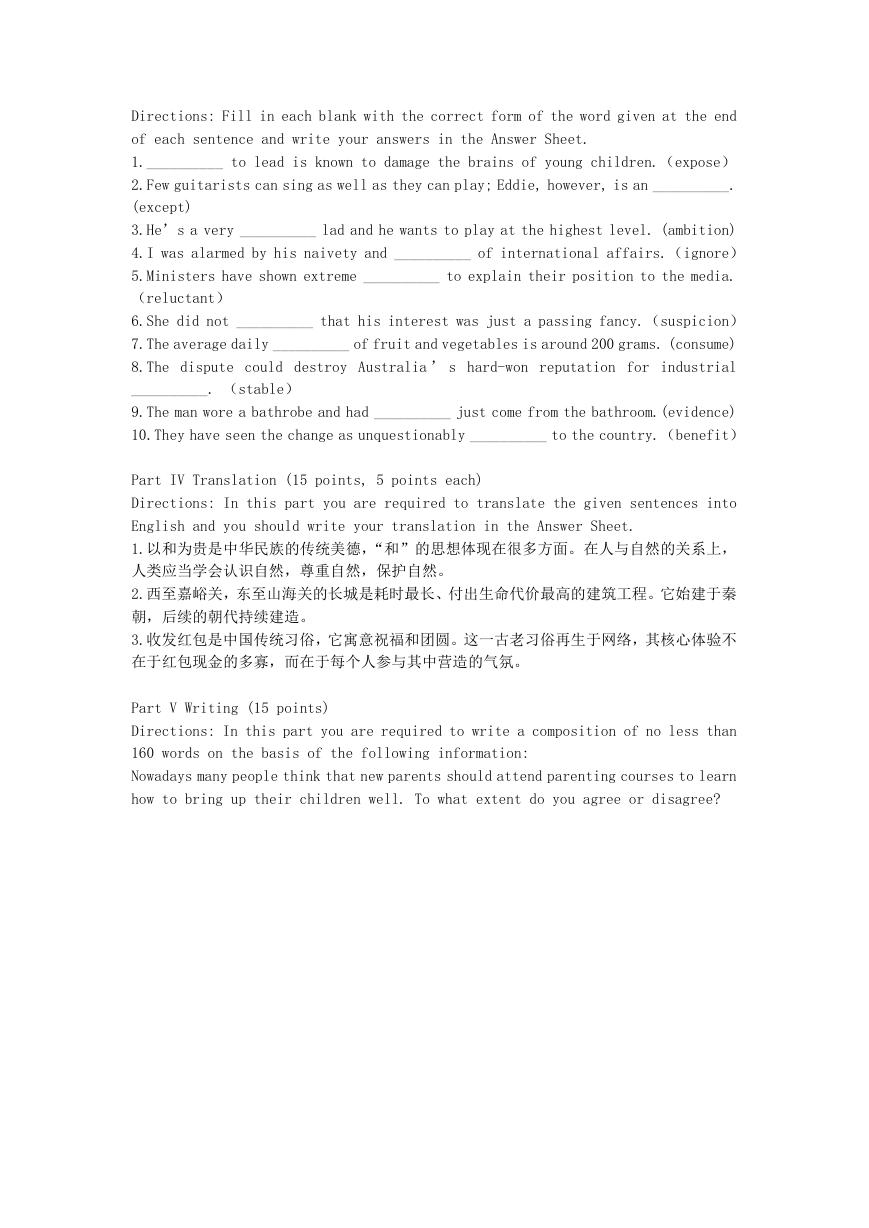








 2023年江西萍乡中考道德与法治真题及答案.doc
2023年江西萍乡中考道德与法治真题及答案.doc 2012年重庆南川中考生物真题及答案.doc
2012年重庆南川中考生物真题及答案.doc 2013年江西师范大学地理学综合及文艺理论基础考研真题.doc
2013年江西师范大学地理学综合及文艺理论基础考研真题.doc 2020年四川甘孜小升初语文真题及答案I卷.doc
2020年四川甘孜小升初语文真题及答案I卷.doc 2020年注册岩土工程师专业基础考试真题及答案.doc
2020年注册岩土工程师专业基础考试真题及答案.doc 2023-2024学年福建省厦门市九年级上学期数学月考试题及答案.doc
2023-2024学年福建省厦门市九年级上学期数学月考试题及答案.doc 2021-2022学年辽宁省沈阳市大东区九年级上学期语文期末试题及答案.doc
2021-2022学年辽宁省沈阳市大东区九年级上学期语文期末试题及答案.doc 2022-2023学年北京东城区初三第一学期物理期末试卷及答案.doc
2022-2023学年北京东城区初三第一学期物理期末试卷及答案.doc 2018上半年江西教师资格初中地理学科知识与教学能力真题及答案.doc
2018上半年江西教师资格初中地理学科知识与教学能力真题及答案.doc 2012年河北国家公务员申论考试真题及答案-省级.doc
2012年河北国家公务员申论考试真题及答案-省级.doc 2020-2021学年江苏省扬州市江都区邵樊片九年级上学期数学第一次质量检测试题及答案.doc
2020-2021学年江苏省扬州市江都区邵樊片九年级上学期数学第一次质量检测试题及答案.doc 2022下半年黑龙江教师资格证中学综合素质真题及答案.doc
2022下半年黑龙江教师资格证中学综合素质真题及答案.doc